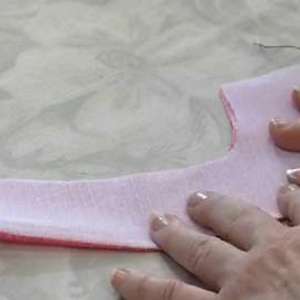
Frequent Threads contributor Daryl Lancaster demonstrates how to finish garment edges with decorative crochet. This method is an alternative to facings, bands, and turned-and-stitched edges. It’s simple to do, and is less bulky along the edges of heavy fabrics. A crocheted edge makes an excellent treatment for garment areas where the right and wrong sides are visible, as it looks good on both sides.
Tools and materials
You’ll need tiny, pointy steel crochet hooks. They can pierce the fabric easily and enable you to grab the crochet material. You can find new hooks, but you may also find nice vintage ones at yard sales or flea markets.
For the trim, consider materials such as needlework wool, embroidery floss, pearl cotton, tapestry yarns (separate the plies if desired), solid or variegated sock or fingering weight yarn, or other relatively fine knitting or crochet materials.
Stabilize the edges first
Before you begin to crochet, stabilize the fabric edge so it can support the crochet. The stabilizing method also functions as a guide for the crochet stitches. You can use a three- or four-thread serged edge, or a machine overedge stitch. You can also apply a narrow cross-grain strip of fusible tricot interfacing along the edge. It’s lightweight and nearly invisible when fused to the fabric’s wrong side. Also consider nylon tricot binding, such as Seams Great. Wrap it around the fabric edge and zigzag it in place. Be sure to choose a material or thread that matches the fabric as closely as possible.
Crochet stitches
Single crochet stitch gives a simple, uniform edge. A double crochet stitch is more substantial and provides a more defined edge appearance. You can also create a decorative picot or scalloped edge, if desired. The crab stitch, or reverse single crochet stitch, produces…


































Fabulous tip! Thank you.
This is a great video. I like to use cloth hankies and I like the ones with a crochet edging. I have tried to make my own before and gave it up as too hard. I think because I was not using a crochet hook with a pointy tip. I plan to try again. I have lots of good quality cotton scraps that will be good for hankies. Thank you Daryl.